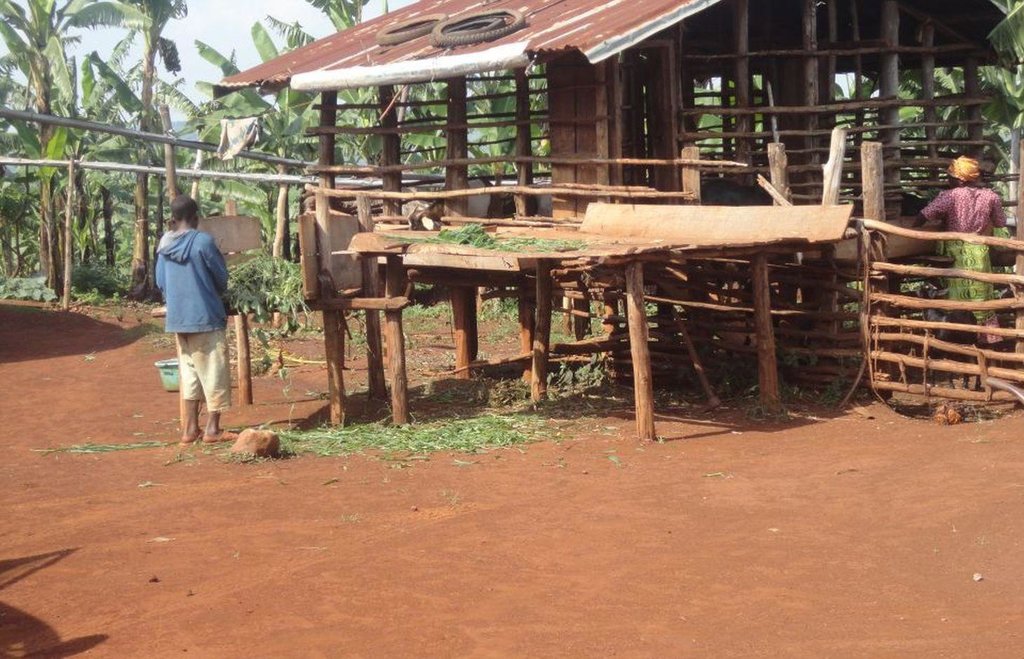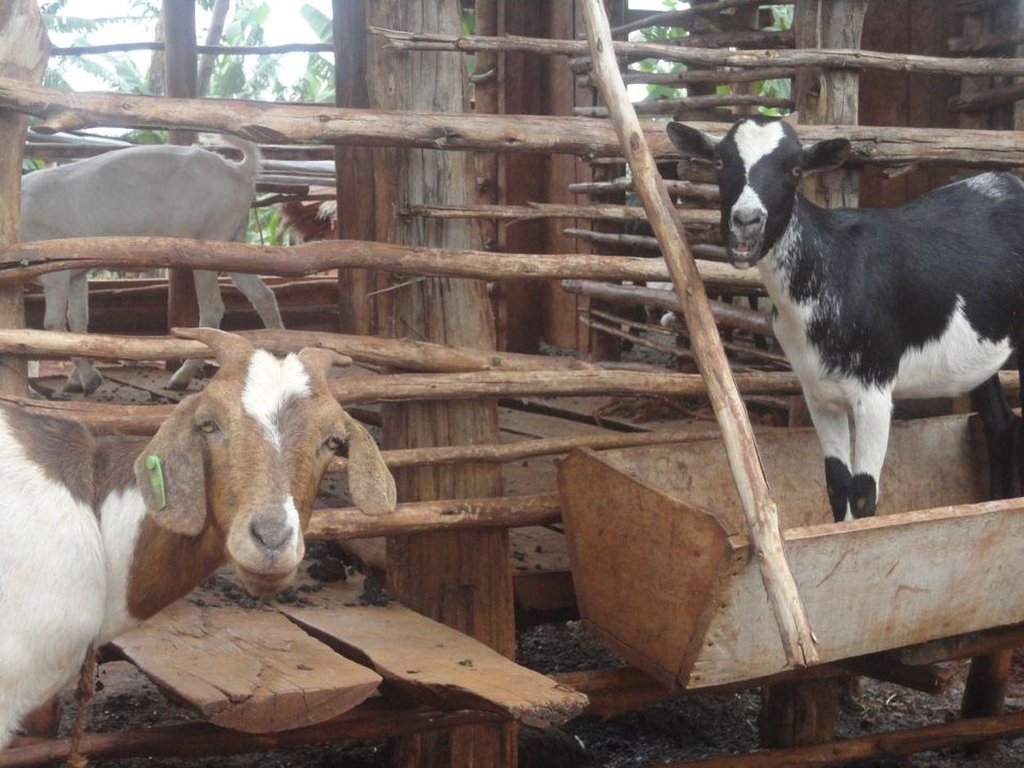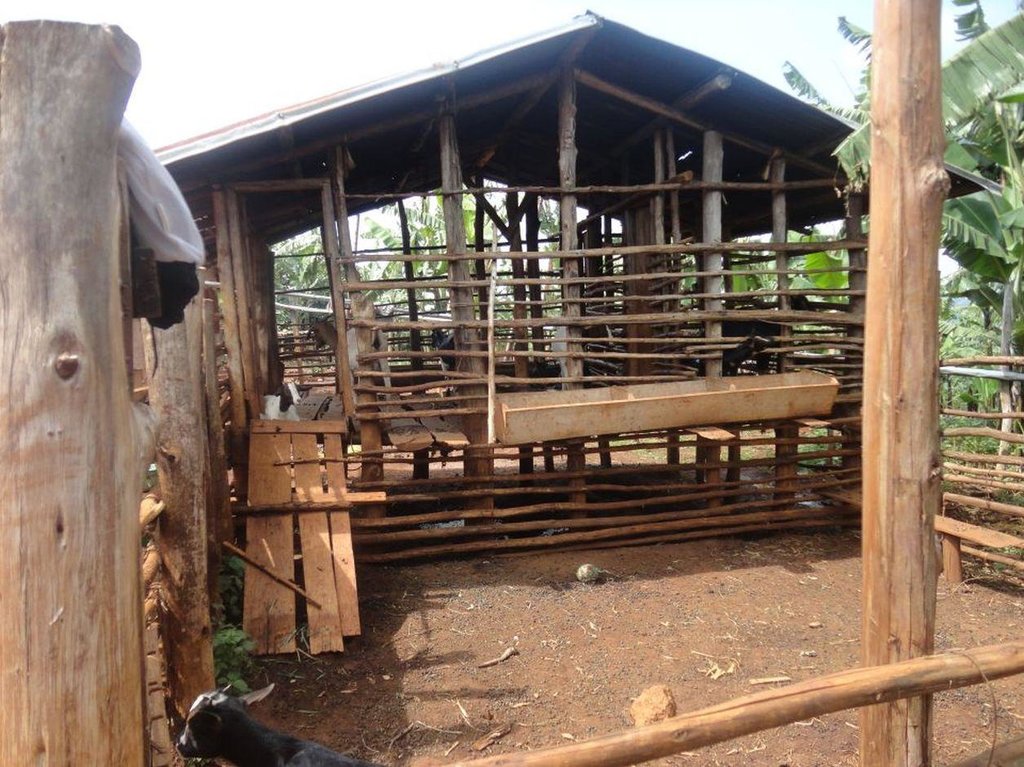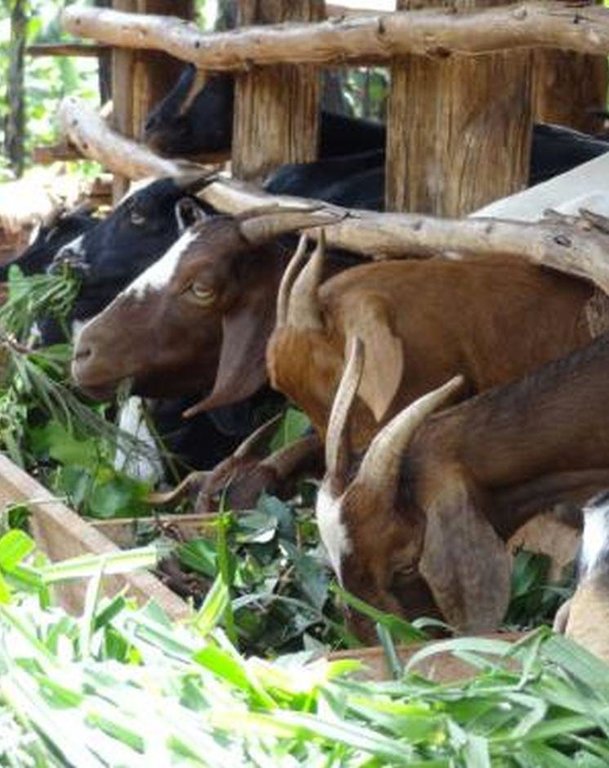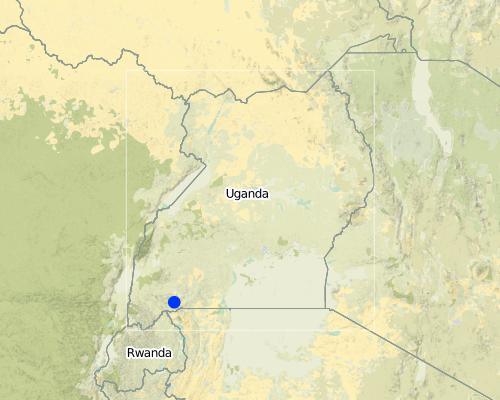Zero grazing [Ouganda]
- Création :
- Mise à jour :
- Compilateur : Wilson Bamwerinde
- Rédacteur : –
- Examinateur : Fabian Ottiger
Okurisiza hamwe
technologies_1188 - Ouganda
Voir les sections
Développer tout Réduire tout1. Informations générales
1.2 Coordonnées des personnes-ressources et des institutions impliquées dans l'évaluation et la documentation de la Technologie
Spécialiste GDT:
Spécialiste GDT:
Spécialiste GDT:
Nom du projet qui a facilité la documentation/ l'évaluation de la Technologie (si pertinent)
The Transboundary Agro-ecosystem Management Project for the Kagera River Basin (GEF-FAO / Kagera TAMP )Nom du ou des institutions qui ont facilité la documentation/ l'évaluation de la Technologie (si pertinent)
Food and Agriculture Organization of the United Nations (FAO) - ItalieNom du ou des institutions qui ont facilité la documentation/ l'évaluation de la Technologie (si pertinent)
Ministry of Agriculture, Animal Industry, and Fisheries of Uganda (MAAIF) - Ouganda1.3 Conditions relatives à l'utilisation par WOCAT des données documentées
Le compilateur et la(les) personne(s) ressource(s) acceptent les conditions relatives à l'utilisation par WOCAT des données documentées:
Oui
2. Description de la Technologie de GDT
2.1 Courte description de la Technologie
Définition de la Technologie:
Stall-fed livestock production is an efficient method to produce organic fertilizers (manure) for the conservation and improvement of soil fertility.
2.2 Description détaillée de la Technologie
Description:
Zero-grazing has been a common livestock (cattle and pigs) management practice in most areas of south-western Uganda due to reduced communal grazing land. In the predominantly annual cropping system communities, free grazing livestock often damage crops and are a major cause of conflict. On the other hand, farmers observe that crop yields have declined season after season. For example, the bunch of bananas has grown smaller, it has smaller fingers, and many banana stands have no fruit during much of the year. The most important ways through which croplands in Rubagano are degraded include nutrient transfer through harvest and crop residue movement and use; nutrient mining whereby continuous cultivation is done with little or no replenishment; and soil and water runoff on steep slopes. Farmers know that one of the most important ways to reverse declining soil fertility is to apply manure, but it is expensive. Therefore farmers acquired goats or pigs primarily for the provision of manure for their cropland, but also as a household income generating enterprise. In stall-fed goat or pig production, The zero-grazing unit is designed in such a way that it is well ventilated and protected from wind, rain and constant direct sunshine to avoid livestock developing coughs, colds and stress. The unit has 3 major parts: the feeding and rest area, the exercise area and the manure collection area. The feeding/rest area is raised 1 m above the ground. Below it is the manure collection area and above it, a corrugated iron roof. There is a feeding vat on each side of the feeding/rest area in which mixed fodder is fed to the livestock. A wooden food preparation slab for cutting and mixing fodder is in front of the feeding/rest area. The unit for housing 12 goats is 4 m by 8 m on the ground and 3 m high at the feeding area.
Purpose of the Technology: The major objective of stall-feeding is to maximize manure collection for sustaining soil fertility in cropland. Other goals are to improve household income, reduce expenditure on pests and disease management through livestock isolation from other animals and to reduce labor by cutting and storing fodder for use over a period instead of grazing in distant pastures daily.
Establishment / maintenance activities and inputs: The materials required for establishment of the zero-grazing unit for goats are wooden posts or poles, cut-off planks, wooden slats/timber, iron sheets and nails. The 4 m by 4 m feeding/rest area is raised 1 m above the ground on strong Eucalyptus or pine posts of diameter 5-10 cm. Its wall is 2 m high and is made of widely spaced cut-off planks or light wooden poles not more than 3 cm diameter nailed to strong upright posts. The floor is made of wooden slats placed 2 cm apart, big enough to allow livestock droppings to fall through but too small for adult goats’ or kids’ hooves pass, in order to avoid injury to livestock. There is a 1.5 m by 0.5 m feeding vat on each side of the feeding/rest area and a 1 m by 1 m fodder mixing wooden slab at the front. On the ground to one side of the feeding/rest area is the 4m by 4m exercise area. The unit can be constructed at any time of the year.
Natural / human environment: Regular maintenance of the unit is done to ensure the floor does not develop holes that can lead to injury of the livestock, and the roof does not leak when it rains. Increased manure collection and application increases crop yields and supports crop diversification.
2.3 Photos de la Technologie
2.5 Pays/ région/ lieux où la Technologie a été appliquée et qui sont couverts par cette évaluation
Pays:
Ouganda
Région/ Etat/ Province:
Uganda
Autres spécifications du lieu:
Mbarara District
Commentaires:
Boundary points of the Technology area: -0.86313 30.62564; -0.86314 30.62561; -0.86316 30.62569; -0.86319 30.62567
Map
×2.6 Date de mise en œuvre de la Technologie
Si l'année précise est inconnue, indiquez la date approximative: :
- il y a moins de 10 ans (récemment)
2.7 Introduction de la Technologie
Spécifiez comment la Technologie a été introduite: :
- par le biais de projets/ d'interventions extérieures
Commentaires (type de projet, etc.) :
This technology was introduced in 2008 by NAADS and later by Africa2000 with aim to improve manure and compost production in Kagera region. Recently, Kagera TAMP project provided additional support to introduce exotic breeds of the goats and increase livestock productivity.
3. Classification de la Technologie de GDT
3.1 Principal(aux) objectif(s) de la Technologie
- réduire, prévenir, restaurer les terres dégradées
- préserver l'écosystème
3.2 Type(s) actuel(s) d'utilisation des terres, là où la Technologie est appliquée

Terres cultivées
- Cultures annuelles
Principales cultures (vivrières et commerciales):
Major cash crop: Irish potatoes, bananas, beans
Major food crop: Irish potatoes, bananas, beans

Pâturages
Pâturage intensif/ production fourragère :
- Affouragement en vert/ zéro-pâturage
Commentaires:
Major land use problems (compiler’s opinion): Reduction of soil organic matter content
Major land use problems (land users’ perception): Decline of soil fertility and decreased crop yields
Cut-and-carry/ zero grazing: Yes
Future (final) land use (after implementation of SLM Technology): Grazing land: Gi: Intensive grazing/ fodder production
Type of cropping system and major crops comments: other crops like peas, millet, maize and sorghum are also grown.
Livestock is grazing on crop residues
Si l'utilisation des terres a changé en raison de la mise en œuvre de la Technologie, indiquez l'utilisation des terres avant la mise en œuvre de la Technologie:
Grazing land: Ge: Extensive grazing land
3.3 Informations complémentaires sur l'utilisation des terres
Approvisionnement en eau des terres sur lesquelles est appliquée la Technologie:
- pluvial
Nombre de période de croissance par an: :
- 2
Précisez:
Longest growing period in days: 120 Longest growing period from month to month: February to May Second longest growing period in days: 90 Second longest growing period from month to month: September to November
3.4 Groupe de GDT auquel appartient la Technologie
- pastoralisme et gestion des pâturages
- gestion intégrée cultures-élevage
3.5 Diffusion de la Technologie
Commentaires:
Total area covered by the SLM Technology is 0.002 km2.
There are 20 zero grazing units (goats and pigs) in the area and with a total area of about 2 hectares. The technology is being adopted slowly throughout the community.
3.6 Mesures de GDT constituant la Technologie

pratiques agronomiques
- A2: Matière organique/ fertilité du sol

pratiques végétales
- V2: Herbes et plantes herbacées pérennes

modes de gestion
- M2: Changement du niveau de gestion / d'intensification
Commentaires:
Main measures: agronomic measures, vegetative measures, management measures
Type of agronomic measures: manure / compost / residues
Type of vegetative measures: aligned: -linear
3.7 Principaux types de dégradation des terres traités par la Technologie

dégradation chimique des sols
- Cn: baisse de la fertilité des sols et réduction du niveau de matière organique (non causée par l’érosion)

dégradation biologique
- Bc: réduction de la couverture végétale
Commentaires:
Main type of degradation addressed: Cn: fertility decline and reduced organic matter content, Bc: reduction of vegetation cover
Main causes of degradation: soil management (Poor methods of cultivation), crop management (annual, perennial, tree/shrub) (Poor agronomic practices), over-exploitation of vegetation for domestic use (Vegetation destroyed for domestic use (firewood and thatch).)
Secondary causes of degradation: education, access to knowledge and support services
3.8 Prévention, réduction de la dégradation ou réhabilitation des terres dégradées
Spécifiez l'objectif de la Technologie au regard de la dégradation des terres:
- prévenir la dégradation des terres
- réduire la dégradation des terres
Commentaires:
Main goals: mitigation / reduction of land degradation
Secondary goals: prevention of land degradation
4. Spécifications techniques, activités, intrants et coûts de mise en œuvre
4.1 Dessin technique de la Technologie
Auteur:
Byonabye Proscovia, Kagera TAMP, Kabala
4.2 Spécification/ explications techniques du dessin technique
Details of zero grazing shed structure : A. Overview of the livestock shed with manure colelction area (below) B. View on the feeding arrangement with the fodder vats abouve ground level C. Deatils of the fodder vat D. Overview of the fodder preparation structures
Location: Rubagano, Mwizi, Mbarara District. Uganda
Date: 29-DEC-2013
Technical knowledge required for field staff / advisors: moderate (Comprehensive knowledge on shed construction (e.g. planning, design of shed levels) and livestock management (fodder quality, feeding, diseases))
Technical knowledge required for land users: moderate (Comprehensive knowledge on shed construction (e.g. planning, design of shed levels) and livestock management (fodder quality, feeding, diseases))
Main technical functions: improvement of ground cover, increase in organic matter, increase in nutrient availability (supply, recycling,…)
Secondary technical functions: improvement of surface structure (crusting, sealing), promotion of vegetation species and varieties (quality, eg palatable fodder)
Manure / compost / residues
Material/ species: Manure (Pigs or goats)
Aligned: -linear
Vegetative material: G : grass
Number of plants per (ha): 900
Vertical interval between rows / strips / blocks (m): 3
Spacing between rows / strips / blocks (m): 3
Grass species: Pennisetum purpereum (napier grass), Calliandra Spp.)
Slope (which determines the spacing indicated above): 25-30%
Change of land use type: Mixed crop and livestock husbandry
Change of land use practices / intensity level: Planting fodder in addition to traditional annual and perennial crops
4.3 Informations générales sur le calcul des intrants et des coûts
autre/ monnaie nationale (précisez):
UGX
Indiquer le taux de change du dollars en monnaie locale (si pertinent): 1 USD= :
2600,0
Indiquez le coût salarial moyen de la main d'œuvre par jour:
3.85
4.4 Activités de mise en place/ d'établissement
| Activité | Type de mesures | Calendrier | |
|---|---|---|---|
| 1. | Purchase of tools | Agronomique | Wet season |
| 2. | Purchase of construction materials | Agronomique | |
| 3. | Construction of zero grazing shed ( including vats and manura collecion area) | Agronomique | |
| 4. | Purchase of livestock | Agronomique | |
| 5. | Grass seed procurement and sowing | Végétale | Wet season |
| 6. | Converting part of the cropland (annual and perrenial crops) into fodder production | Modes de gestion |
4.5 Coûts et intrants nécessaires à la mise en place
| Spécifiez les intrants | Unité | Quantité | Coûts par unité | Coût total par intrant | % des coût supporté par les exploitants des terres | |
|---|---|---|---|---|---|---|
| Main d'œuvre | Construction of zero grazing shed ( including vats and manura collecion area) | ha | 1,0 | 115,4 | 115,4 | 100,0 |
| Equipements | Tools | Set | 1,0 | 115,4 | 115,4 | 100,0 |
| Matériaux de construction | Tree poles,nails,sorghum stalk | ha | 1,0 | 38,46 | 38,46 | 100,0 |
| Matériaux de construction | Corrugated iron sheets | ha | 1,0 | 250,0 | 250,0 | 100,0 |
| Autre | Livestock (3 Does) | ha | 1,0 | 173,1 | 173,1 | 100,0 |
| Coût total de mise en place de la Technologie | 692,36 | |||||
Commentaires:
Duration of establishment phase: 6 month(s)
Lifespan of:
Tools - 1 year
Construction material - 10 years
Zero grazing shed - 1 year
Livestock - 20 years
4.6 Activités d'entretien/ récurrentes
| Activité | Type de mesures | Calendrier/ fréquence | |
|---|---|---|---|
| 1. | Cutting and carrying and application of fodder | Agronomique | Daily |
| 2. | Collection, composting and application of manure | Agronomique | Daily |
| 3. | Purchase of tools and materials for reconstruction/repairs of the shed structure | Agronomique | annual |
| 4. | Weeding and gapping | Végétale | Seasonal |
4.7 Coûts et intrants nécessaires aux activités d'entretien/ récurrentes (par an)
| Spécifiez les intrants | Unité | Quantité | Coûts par unité | Coût total par intrant | % des coût supporté par les exploitants des terres | |
|---|---|---|---|---|---|---|
| Main d'œuvre | Labour | ha | 1,0 | 38,46 | 38,46 | |
| Equipements | Tools | ha | 1,0 | 11,54 | 11,54 | 100,0 |
| Matériaux de construction | Tree poles,nails,sorghum stalk | ha | 1,0 | 3,85 | 3,85 | 100,0 |
| Matériaux de construction | Corrugated iron sheets | ha | 1,0 | |||
| Autre | Livestock (3 Does) | ha | 1,0 | 18,0 | 18,0 | 100,0 |
| Coût total d'entretien de la Technologie | 71,85 | |||||
Commentaires:
Machinery/ tools: Panga, hoe, tree poles nails, soka jembe, spade, and wheel barrow., Hand hoe, panga.
The costs were calculated for the construction of the shed, acquisition of 3 does and establishment of fodder crops on part of cropland formerly used for annual and perrenial crops. The calculations were done for the technology in August 2011.
4.8 Facteurs les plus importants affectant les coûts
Décrivez les facteurs les plus importants affectant les coûts :
The most determinate factors in the establishment of the technology are: labour for planting, maintaining and cutting grass and other pastures and carrying the fodder to the zero-grazing unit; labour for fetching water for the animals; and labour for removing and composting manure and spreading into the garden.
5. Environnement naturel et humain
5.1 Climat
Précipitations annuelles
- < 250 mm
- 251-500 mm
- 501-750 mm
- 751-1000 mm
- 1001-1500 mm
- 1501-2000 mm
- 2001-3000 mm
- 3001-4000 mm
- > 4000 mm
Spécifiez la pluviométrie moyenne annuelle (si connue), en mm:
1041,00
Zone agro-climatique
- subhumide
Thermal climate class: tropics. All months above 18°C.
Rubagano receives at least 6 months of rain in 2 seasons, February to May and September to November
5.2 Topographie
Pentes moyennes:
- plat (0-2 %)
- faible (3-5%)
- modéré (6-10%)
- onduleux (11-15%)
- vallonné (16-30%)
- raide (31-60%)
- très raide (>60%)
Reliefs:
- plateaux/ plaines
- crêtes
- flancs/ pentes de montagne
- flancs/ pentes de colline
- piémonts/ glacis (bas de pente)
- fonds de vallée/bas-fonds
Zones altitudinales:
- 0-100 m
- 101-500 m
- 501-1000 m
- 1001-1500 m
- 1501-2000 m
- 2001-2500 m
- 2501-3000 m
- 3001-4000 m
- > 4000 m
Indiquez si la Technologie est spécifiquement appliquée dans des:
- situations concaves
Commentaires et précisions supplémentaires sur la topographie:
Altitudinal zone: 1501-2000 m a.s.l. (1740 m.a.s.l)
Slopes on average: Hilly (Fairly steep slopes in places)
5.3 Sols
Profondeur moyenne du sol:
- très superficiel (0-20 cm)
- superficiel (21-50 cm)
- modérément profond (51-80 cm)
- profond (81-120 cm)
- très profond (>120 cm)
Texture du sol (de la couche arable):
- grossier/ léger (sablonneux)
Matière organique de la couche arable:
- moyen (1-3%)
Si disponible, joignez une description complète du sol ou précisez les informations disponibles, par ex., type de sol, pH/ acidité du sol, capacité d'échange cationique, azote, salinité, etc.
Soil depth on average: Shallow (Mother rock easily reached on pitting)
Soil texture: Coarse/light (Sand and stones)
Soil fertility: Low (Fertility depleted; being slowly replenished by application of technology)
Soil drainage/infiltration: Good (Water easily penetrates into the soil)
Soil water storage capacity: Low (Crops easily dry during the dry spell)
5.4 Disponibilité et qualité de l'eau
Profondeur estimée de l’eau dans le sol:
> 50 m
Disponibilité de l’eau de surface:
faible/ absente
Qualité de l’eau (non traitée):
faiblement potable (traitement nécessaire)
Commentaires et précisions supplémentaires sur la qualité et la quantité d'eau:
Ground water table: >50m (Not possible to reach water table)
Availability of surface water: Poor/none (No surface water except when it rains)
Water quality (untreated): Poor drinking water (treatement required, muddy water collected by damming runoff in natural rock depressions)
5.5 Biodiversité
Diversité des espèces:
- faible
Commentaires et précisions supplémentaires sur la biodiversité:
Low, noticed improvements after application of the technology
5.6 Caractéristiques des exploitants des terres appliquant la Technologie
Orientation du système de production:
- mixte (de subsistance/ commercial)
Revenus hors exploitation:
- 10-50% de tous les revenus
Niveau relatif de richesse:
- moyen
Individus ou groupes:
- individu/ ménage
Niveau de mécanisation:
- travail manuel
Genre:
- femmes
- hommes
Indiquez toute autre caractéristique pertinente des exploitants des terres:
Land users applying the Technology are mainly common / average land users
Difference in the involvement of women and men: No difference in involvement of men and women.
Population density: 100-200 persons/km2
Annual population growth: 2% - 3%
14% of the land users are rich and own 37% of the land.
48% of the land users are average wealthy and own 42% of the land.
21% of the land users are poor and own 14% of the land.
17% of the land users are poor and own 7% of the land.
Off-farm income specification: There is increased yield where the technology has been applied, increasing the income generated on-site thereby reducing off-farm percentage.
Level of mechanization: Manual work (use hand hoes)
Market orientation: Mixed (Some crops are sold to generate household income. Goats will be mainly for sale)
5.7 Superficie moyenne des terres détenues ou louées par les exploitants appliquant la Technologie
- < 0,5 ha
- 0,5-1 ha
- 1-2 ha
- 2-5 ha
- 5-15 ha
- 15-50 ha
- 50-100 ha
- 100-500 ha
- 500-1 000 ha
- 1 000-10 000 ha
- > 10 000 ha
Cette superficie est-elle considérée comme de petite, moyenne ou grande dimension (en se référant au contexte local)?
- petite dimension
Commentaires:
Some households have more while others have less land.
5.8 Propriété foncière, droits d’utilisation des terres et de l'eau
Propriété foncière:
- individu, sans titre de propriété
Droits d’utilisation des terres:
- individuel
Droits d’utilisation de l’eau:
- accès libre (non organisé)
- individuel
Commentaires:
Individual land ownership. Recent introduction of the water harvesting measures provided land owners with access to own water sources
5.9 Accès aux services et aux infrastructures
santé:
- pauvre
- modéré
- bonne
éducation:
- pauvre
- modéré
- bonne
assistance technique:
- pauvre
- modéré
- bonne
emploi (par ex. hors exploitation):
- pauvre
- modéré
- bonne
marchés:
- pauvre
- modéré
- bonne
énergie:
- pauvre
- modéré
- bonne
routes et transports:
- pauvre
- modéré
- bonne
eau potable et assainissement:
- pauvre
- modéré
- bonne
services financiers:
- pauvre
- modéré
- bonne
6. Impacts et conclusions
6.1 Impacts sur site que la Technologie a montrés
Impacts socio-économiques
Production
production agricole
Quantité avant la GDT:
10kg
Quantité après la GDT:
60kg
Commentaires/ spécifiez:
increased yields for beans realised.
production fourragère
qualité des fourrages
production animale
risque d'échec de la production
diversité des produits
surface de production
Revenus et coûts
revenus agricoles
Quantité avant la GDT:
23dollars per yr
Quantité après la GDT:
92 dollars per yr.
Commentaires/ spécifiez:
yields increased from sell of goats
diversité des sources de revenus
charge de travail
Commentaires/ spécifiez:
As there is now a lot more activity on-farm
Impacts socioculturels
sécurité alimentaire/ autosuffisance
institutions communautaires
institutions nationales
connaissances sur la GDT/ dégradation des terres
Commentaires/ spécifiez:
Vegetation cover has been improved.
Improved livelihoods and human well-being
Commentaires/ spécifiez:
Food security and household income have improved. This has resulted in children in these households having more time for school and in case of illness, there in some money for accessing treatment.
Impacts écologiques
Sols
couverture du sol
cycle/ recharge des éléments nutritifs
matière organique du sol/ au dessous du sol C
Biodiversité: végétale, animale
biomasse/ au dessus du sol C
diversité des habitats
6.2 Impacts hors site que la Technologie a montrés
dommages sur les champs voisins
Commentaires/ spécifiez:
livestock is confined
6.3 Exposition et sensibilité de la Technologie aux changements progressifs et aux évènements extrêmes/catastrophes liés au climat (telles que perçues par les exploitants des terres)
Changements climatiques progressifs
Changements climatiques progressifs
| Saison | Type de changements/ extrêmes climatiques | Comment la Technologie fait-elle face à cela? | |
|---|---|---|---|
| températures annuelles | augmente | bien |
Extrêmes climatiques (catastrophes)
Catastrophes météorologiques
| Comment la Technologie fait-elle face à cela? | |
|---|---|
| pluie torrentielle locale | bien |
Catastrophes climatiques
| Comment la Technologie fait-elle face à cela? | |
|---|---|
| sécheresse | bien |
Commentaires:
Forage and fodder usually become scorched during seasons of long drought and livestock may die from lack of food. Grass is cut in the wet season while it is plentiful and turned into hay for the time of scarcity. For this, a barn unit needs to be constructed.
6.4 Analyse coûts-bénéfices
Quels sont les bénéfices comparativement aux coûts de mise en place (du point de vue des exploitants des terres)?
Rentabilité à court terme:
négative
Rentabilité à long terme:
très positive
Quels sont les bénéfices comparativement aux coûts d'entretien récurrents (du point de vue des exploitants des terres)?
Rentabilité à court terme:
positive
Rentabilité à long terme:
très positive
Commentaires:
The benefits far outweigh the establishment and maintenance costs. The negative on short-term returns is due to the cost of the technology (construction and procuring livestock) which is a little high for the farmers in this area.
6.5 Adoption de la Technologie
Si disponible, quantifiez (nombre de ménages et/ou superficie couverte):
20 on 2 hectares
Parmi tous ceux qui ont adopté la Technologie, combien d'entre eux l'ont fait spontanément, à savoir sans recevoir aucune incitation matérielle ou aucun paiement?
- 10-50%
Commentaires:
90% of land user families have adopted the Technology with external material support
18 land user families have adopted the Technology with external material support
Comments on acceptance with external material support: The does were supplied to farmers using project funds.
10% of land user families have adopted the Technology without any external material support
2 land user families have adopted the Technology without any external material support
Comments on spontaneous adoption: these farmers are rich and procured the technology without support from the project
There is a moderate trend towards spontaneous adoption of the Technology
Comments on adoption trend: 20 households in one village have adopted the technology
6.7 Points forts/ avantages/ possibilités de la Technologie
| Points forts/ avantages/ possibilités du point de vue de l'exploitant des terres |
|---|
|
Technology easy to establish and maintain How can they be sustained / enhanced? Proper management of the livestock |
|
Helps in soil fertility management How can they be sustained / enhanced? Good manure management |
|
Imporove soil cover and reduce soil erosion How can they be sustained / enhanced? using the manure in a proper /recommended way i.e. using it when planting or putting it in the plot before primary cultivation |
| Points forts/ avantages/ possibilités du point de vue du compilateur ou d'une autre personne ressource clé |
|---|
|
Animals are fed on selected pasture How can they be sustained / enhanced? Promote the growing of that pasture |
|
The technology promotes us of organic manure How can they be sustained / enhanced? Use of compost pits to recycle the wastes into manure |
6.8 Faiblesses/ inconvénients/ risques de la Technologie et moyens de les surmonter
| Faiblesses/ inconvénients/ risques du point de vue du compilateur ou d'une autre personne ressource clé | Comment peuvent-ils être surmontés? |
|---|---|
| The technology may contribute to loss of vegetation | Planting pasture & other grass for feeding the animals |
7. Références et liens
7.2 Références des publications disponibles
Titre, auteur, année, ISBN:
Kagera TAMP project website
Disponible à partir d'où? Coût?
http://www.fao.org/nr/kagera/en/
Liens et modules
Développer tout Réduire toutLiens
Aucun lien
Modules
Aucun module trouvé



